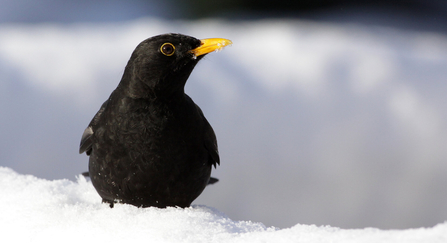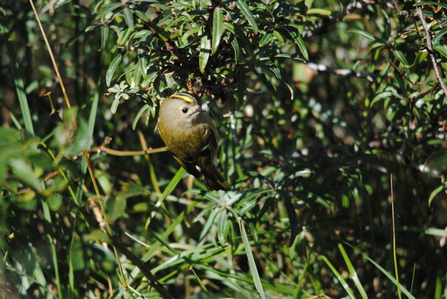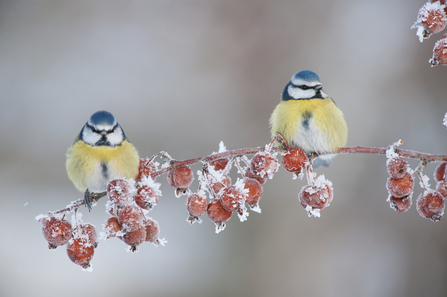The autumn migration of birds that will spend the winter with us tends to be overshadowed by the departure of our familiar summer migrants, most notably the Swallows and House Martins that so obviously gather in large groups on wires or foraging flocks over our towns and villages before heading south, but there is another group of birds that fly long distances across land and sea with the British Isles as their destination.
The importance of Autumn berries and seeds
Chris Gomersall

Margaret Holland
On arrival some of them, Blackbirds, Robins and Goldcrests for instance, will blend in unnoticed with the resident birds, but there are a few species that we only see in the colder half of the year: of which Fieldfares, Redwings and Bramblings are the most obvious species we are likely to encounter.

Amy Lewis
What makes Redwings fly to Shropshire all the way from Arctic Russia, or compels a Goldcrest that normally weighs 4-6 grams to attempt a nocturnal crossing of the North Sea? Ultimately the answer are two things that motivate most animals in winter: food and warmth.
Protected by the buffering effects of the sea, our islands enjoy temperatures that are generally milder than continental North West Europe, less prone to debilitating periods of freezing conditions or snow cover, and despite being one of the most nature depleted nations in Europe there is still lots of natural food available, often supplemented by garden bird feeders in populated areas.
As is always the case with natural history we can enjoy the sight of flocks of birds moving through a wood or hedge as a spectacle in its own right, or we can look a little closer, and start to ask some questions such as “Who eats what? And why?”
The first place to look is the bill, specifically its shape, sometimes regarded as one of the main gateways to bird identification. In simple terms seed-eaters will have shorter, deeper bills to open seeds, while birds that consume insects and fruit will have longer, thinner bills.
If we look closer again we can see differentiation even within the seed-eaters. Compare the long fine bill of the Goldfinch, perfect for skilfully extracting thistle or teasel seeds one at a time, with the massive bill of the Hawfinch, strong enough to crack open cherry stones or hornbeam seeds. Even more specialised is the Crossbill, that uses its crossed bill to open conifer cones and extract the seeds hidden deep within. Greenfinches, a large finch just a size down from Hawfinches, have stout bills that can tear open rose hips to get at the seeds and pulp within, while the more delicate bill of the Bullfinch is better suited to feeding on the seeds of docks, nettles or shrivelled blackberries or, in late winter and early spring, nutritious buds, a niche few other birds exploit.
What’s happening here is something quite clever, a way for lots of different birds to specialise in particular feeding techniques and create their own ecological niche. This “resource partitioning” can be seen within the tit family if you stop and watch them for a while.

Mark Hamblin/2020Vision
A winter tit flock is usually heard before it is seen, and will often be a mixed band of Blue Tits and Great Tits with other species tagging along to benefit from the extra pairs of eyes looking out for food and predators. You can expect to see Goldcrests and Treecreepers and perhaps Coal Tits or, in milder winters, a Chiffchaff associating with the flock.
Look more closely and you may see that the birds are all feeding in the tree, but in different parts of it. The Blue Tits will be working the thinner limbs and seem to be as happy feeding upside down as the right way up. The Great Tits, being larger, will be on the thicker limbs or dropping down to feed on the woodland floor, where their greater strength lets them hack into beech mast, but for the smaller birds, the Coal Tits and even more so for the Goldcrests, look at the fine twigs on the outermost canopy. They will be pushed in that direction by competition from the more robust Blue and Great Tits that don’t want to be exposed to the increased risk of predation associated with being out on the edge, and pulled there by the prospects of hard-to-reach food that the other tits struggle to exploit.
Tits have an insect eater’s bill but research has shown that Great Tits modify their bill shape over the course of the year by wiping the bill edges on hard surfaces such as twigs during the spring, in effect honing the bill as we would hone a knife’s edge with a steel. In late summer and autumn this behaviour stops and the bills become relatively more robust and better suited to the change in diet from soft-bodied insects to seeds. At the same time the digestive tract increases in length to allow for more nutrients to be extracted from the harder to digest plant-based diet. It’s fascinating that a common garden bird such as the Great Tit can modify its body in such a way to make the most of the feeding opportunities at different times of year.
Equally sophisticated processes are happening within most of the birds that we’re likely to see. Strong easterly winds in mid-October saw a massed arrival of winter thrushes – Fieldfares and Redwings – in Shropshire. Most of these birds will have travelled from Scandinavia or Russia and, like our more familiar resident thrushes, will feed on soil invertebrates, particularly earthworms, and berries, often tending to feed on the ground on mild days and taking to the berries when the ground is frosted or frozen.
Just like humans, birds that are active during daylight rely on vision as their primary sense, but they have superior colour vision to us, crucially being able to see ultraviolet light as well. Most mammals are dichromats, seeing just two primary colours. Humans and most other Old World primates are trichromats, adding red to the colours that can be identified. It’s thought that this allowed us to detect when fruits are ripe enough to be digested and was probably developed alongside the plants that benefit from having their seeds distributed by the mammalian gut, but only when the seeds are fully developed and viable.
Most birds take this a stage further and are tetrachromats, adding ultraviolet to the receptors in the eye. Woodpigeons are pentachromats, seeing five “primary colours”, but that’s for another time! Being able to see into the ultraviolet spectrum allows birds to detect even more subtle information by looking at berries. A cow or dog would only see haws (hawfinch berries) as being one colour, but a human is able to separate the red, ripe ones, from unripe berries. Thrushes can distinguish between haws that are rich in sugars and others that are rich in fats, and will move to feed on bushes bearing slow-release fat in the late afternoon to help fuel them through the long, cold winter nights, but will then choose berries that are rich in sugar for a rapid release of energy in the morning.
That’s quite an impressive adaptation at the microscopic scale of what happens within a bird’s retina, but birds also display impressive feats of foraging adaptation at a much larger scale. If we get sudden bursts of cold weather, particularly resulting in the ground being frozen or covered in snow, we can expect to see weather movements of birds from finches up to geese as birds escape from the harsh conditions, but every November sees a spectacular migration of Woodpigeons, irrespective of weather conditions. As they’re relatively large birds and the flocks usually contain thousands of birds, these movements are hard to miss. The current thinking is that these are mostly birds from Scotland and northern England heading towards France. Some observers have reported more than 30,000 birds flying overhead in one day!
Less obvious but much rarer is an irruption of Waxwings. These striking, Starling-sized birds with head crests and flashes of what looks like red sealing wax in the wings may only be seen in Shropshire around once a decade and is chiefly dependent on the species’ reliance on berries, particularly rowan, as a winter food source. Reports from Finland and Scandinavia suggest a poor berry crop this year and large flocks of Waxwings have already been seen moving south. The Sorbus berries they prefer are often used in amenity plantings so these beautiful but rare northern invaders could be appearing at an industrial car park near you. A flash of colourful Arctic wildness that you can see outside your local supermarket. Aren’t birds brilliant?!

